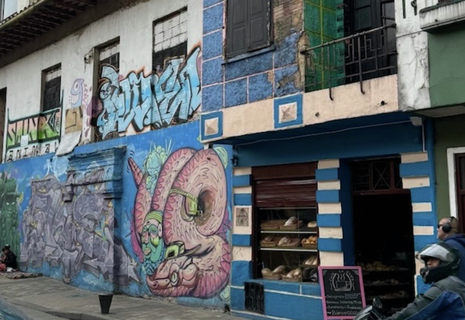Where’s all the street art? My Cambridge culture shock
Having spent one year away from home, Abril Duarte-González reflects upon the varying functions of street art in Bogotá, Colombia, and Cambridge

Colombia’s sprawling mega-capital, Bogotá – where I spent much of my childhood – is covered in graffiti. When I told my family about the prospect of writing this article, I was warned not to give Colombia a bad reputation, especially when the media so often feeds non-Latin Americans a steady diet of violent news. But street art and graffiti in my city don’t just reflect our history of conflict; they write out Bogotá’s complex realities, its hopes, and grievances. It is a form of representation within public space, and even a means of resistance.
The city fosters this culture not just because graffiti is an accessible art form for public consumption, but because of a turning point in 2011, when 16-year-old Diego Felipe Becerra, known as ‘Tripodo,’ was murdered by police while spray-painting his signature Felix the Cat under a bridge on 116th Street. Public outrage led the local government to largely decriminalize graffiti. Now, the worst the police might do is fine you. But even in the 1980s, when President Belisario Betancur secured Colombia’s first peace agreement with the FARC (Revolutionary Armed Forces of Colombia), he invited citizens to “paint peace” in the streets. Bogotá’s walls became canvases of political expression. It quickly became clear that any crackdown on graffiti was never just about vandalism – it was about controlling the message.
Murals memorialize the falsos positivos (false positives): civilians who disappeared during Colombia’s long wars over emerald mines, guerrilla, and paramilitary groups. One notable work, Desaparecidxs, interrogates the streets by asking: Where are the 80,000 people who disappeared during the conflict? Others denounce the authorities: Nos están matando (They are killing us) and ¿Quién dio la orden? (Who gave the orders?), appearing across walls like collective questions.
Recurring images of Indigenous and rural workers – reminiscent of Maoist propaganda – highlight the exploitation of Colombia’s countryside, where at least 1.5 million of Bogotá’s 8 million residents are displaced farmers. It becomes an aesthetic dialogue that interrupts the hegemony of Colombian popular culture and pushes toward what some might consider an “Indigenous look.” Even a tag on a schoolyard wall can be an act of community empowerment. And with American hip-hop’s growing influence on our reggaetón imaginaries, young people grab spray cans and mark their territory.
During times of social tension and political unease, like the National Protests in 2021, concrete walls became an urban scream against government policy: in this case, they became conduits for demands for universal basic income amid tax increases and COVID-era financial strain. Messages such as hasta que nos escuchen (“until they hear us”) were inscribed by social movements onto walls across the city.
“During times of social tension and political unease, like the National Protests in 2021, concrete walls became an urban scream against government policy”
In the gentrified neighbourhood of La Candelaria, moreover, hipster cafés now commission street artists to paint murals of gold. Coffee beans, pre-Hispanic ancestry, and Gabriel García Márquez act as artistic branding for overpriced bookstores and tourist street art tours. That landlords now pay for murals to deter low-grade tagging reflects Bogotá’s evolving relationship with graffiti.
It’s easy to conclude that street art reclaims public space from an elite that hoards art in museums and galleries, many of which are inaccessible to the masses. This touches on postcolonial discourse, too, by rejecting monumental art. In this way, the experience and process of street art can even become cathartic for a population frequently under-represented or misrepresented. It manifests a real desire among Colombians to redefine public space. Walk our streets, and you’ll see what makes Colombians tick. Truth be told, Colombia never runs out of things that make us tick to then get scrawled on walls like silent cries: power, politics, guerrilla warfare, drugs, race.
“Graffiti could serve as a public expression to assert belonging and claim space”
Then I moved to the UK. Even London’s rich array of street art doesn’t compare to the kaleidoscope of stylized tags, stenciled faces, and poetry that fills Bogotá’s streets. But where do we see what makes people tick in Cambridge? Graffiti does surface here, mostly in moments of protest – fleeting Just Stop Oil or pro-Palestine slogans, red paint sloshed on university offices or Senate buildings, followed swiftly by university statements condemning the vandalism and cleaning them up. We also see etching on chapel pews or satirical Latin inscriptions on benches sometimes. Farther out, you’ll find ultramodern, Banksy-esque work like the quirky herrings on Mill Road and Cherry Hinton, aiming to “give Cambridge its own unique urban mascot.”
The lack of graffiti in Cambridge reveals something deeper about how we perceive ourselves and our relationship to public space. As students, it’s easy to feel like outsiders – transient and insignificant in an institution that is distant and immovable. The buildings around us, or rather what they can come to represent, are placed on such high pedestals that they become untouchable, physically and symbolically. Graffiti could serve as a public expression to assert belonging and claim space. It’s not necessarily about disrespecting public and private property, but about challenging who gets to leave a mark and who feels entitled to shape the city. It is a question of ownership. As Bogota’s street art demonstrates, Cambridge could benefit from fostering a culture – maybe not exclusively through graffiti – that allows students to reclaim a sense of ownership, despite our often temporary residence here.
Of course, Cambridge isn’t Bogotá. My city doesn’t have an 800-year history, or a student population of aspiring intellectuals and establishment bourgeoisie. The difference in street art is entirely symptomatic of how the two cities operate on entirely different cultural logics. Bogotá’s graffiti seeks to prove that public space shouldn’t just reflect power but also confront it. But until you see Bogotá for yourself, I’ll be your informed (and biased!) adviser: art should be plastered on every street corner – especially if it disrupts, disquiets and demands to be heard.
 Comment / Don’t get lost in the Bermuda Triangle of job hunting 24 November 2025
Comment / Don’t get lost in the Bermuda Triangle of job hunting 24 November 2025 News / Union elections kick off with contested presidential race22 November 2025
News / Union elections kick off with contested presidential race22 November 2025 News / News in Brief: Cat-astrophic climbs, concealed collections, and Christmas festivities25 November 2025
News / News in Brief: Cat-astrophic climbs, concealed collections, and Christmas festivities25 November 2025 News / Join Varsity’s editorial team this Lent 24 November 2025
News / Join Varsity’s editorial team this Lent 24 November 2025 Theatre / How to plan an American stage tour 25 November 2025
Theatre / How to plan an American stage tour 25 November 2025









